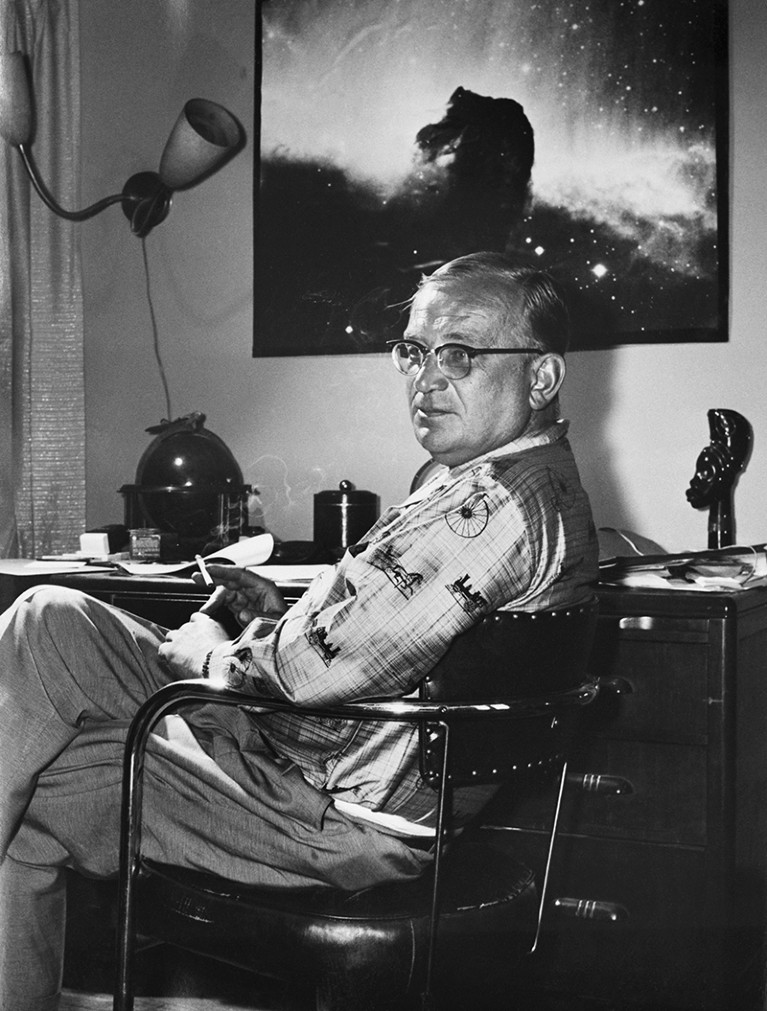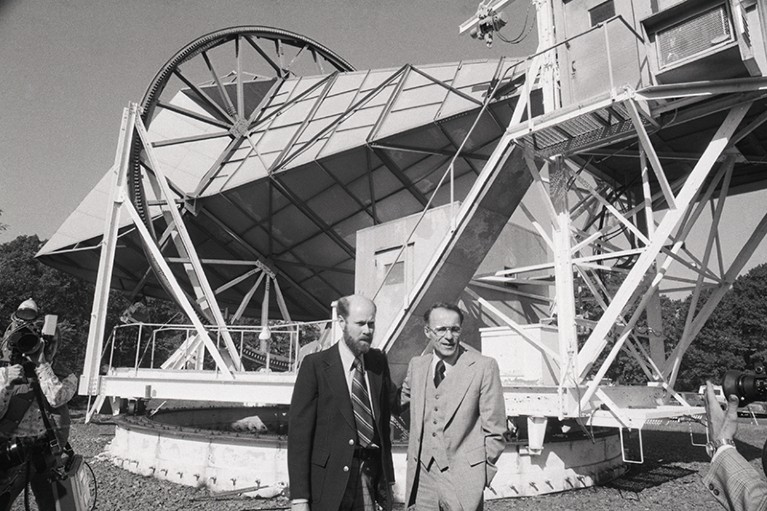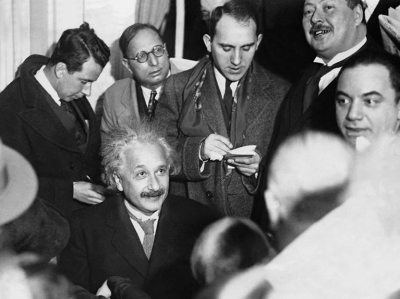[ad_1]
“Words are like harpoons,” UK physicist and astronomer Fred Hoyle told an interviewer in 1995. “Once they go in, they are very hard to pull out.” Hoyle, then 80 years old, was referring to the term Big Bang, which he had coined on 28 March 1949 to describe the origin of the Universe. Today, it is a household phrase, known to and routinely used by people who have no idea of how the Universe was born some 14 billion years ago. Ironically, Hoyle deeply disliked the idea of a Big Bang and remained, until his death in 2001, a staunch critic of mainstream Big Bang cosmology.
Several misconceptions linger concerning the origin and impact of the popular term. One is whether Hoyle introduced the nickname to ridicule or denigrate the small community of cosmologists who thought that the Universe had a violent beginning — a hypothesis that then seemed irrational. Another is that this group adopted ‘Big Bang’ eagerly, and it then migrated to other sciences and to everyday language. In reality, for decades, scientists ignored the catchy phrase, even as it spread in more-popular contexts.
This new map of the Universe suggests dark matter shaped the cosmos
The first cosmological theory of the Big Bang type dates back to 1931, when Belgian physicist and Catholic priest Georges Lemaître proposed a model based on the radioactive explosion of what he called a “primeval atom” at a fixed time in the past. He conceived that this primordial object was highly radioactive and so dense that it comprised all the matter, space and energy of the entire Universe. From the original explosion caused by radioactive decay, stars and galaxies would eventually form, he reasoned. Lemaître spoke metaphorically of his model as a “fireworks theory” of the Universe, the fireworks consisting of the decay products of the initial explosion.
However, Big Bang cosmology in its modern meaning — that the Universe was created in a flash of energy and has expanded and cooled down since — took off only in the late 1940s, with a series of papers by the Soviet–US nuclear physicist George Gamow and his US associates Ralph Alpher and Robert Herman. Gamow hypothesized that the early Universe must have been so hot and dense that it was filled with a primordial soup of radiation and nuclear particles, namely neutrons and protons. Under such conditions, those particles would gradually come together to form atomic nuclei as the temperature cooled. By following the thermonuclear processes that would have taken place in this fiery young Universe, Gamow and his collaborators tried to calculate the present abundance of chemical elements in an influential 1948 paper1.
Competing ideas
The same year, a radically different picture of the Universe was announced by Hoyle and Austrian-born cosmologists Hermann Bondi and Thomas Gold. Their steady-state theory assumed that, on a large scale, the Universe had always looked the same and would always do so, for eternity. According to Gamow, the idea of an ‘early Universe’ and an ‘old Universe’ were meaningless in a steady-state cosmology that posited a Universe with no beginning or end.
Over the next two decades, an epic controversy between these two incompatible systems evolved. It is often portrayed as a fight between the Big Bang theory and the steady-state theory, or even personalized as a battle between Gamow and Hoyle. But this is a misrepresentation.

Soviet–US nuclear physicist George Gamow was an early proponent of Big Bang cosmology.Credit: Bettmann/Getty
Both parties, and most other physicists of the time, accepted that the Universe was expanding — as US astronomer Edwin Hubble demonstrated in the late 1920s by observing that most galaxies are rushing away from our own. But the idea that is so familiar today, of the Universe beginning at one point in time, was widely seen as irrational. After all, how could the cause of the original explosion be explained, given that time only came into existence with it? In fact, Gamow’s theory of the early Universe played almost no part in this debate.
Rather, a bigger question at the time was whether the Universe was evolving in accordance with German physicist Albert Einstein’s general theory of relativity, which predicted that it was either expanding or contracting, not steady. Although Einstein’s theory doesn’t require a Big Bang, it does imply that the Universe looked different in the past than it does now. And an ever-expanding Universe does not necessarily entail the beginning of time. An expanding Universe could have blown up from a smaller precursor, Lemaître suggested in 1927.
An apt but innocent phrase
On 28 March 1949, Hoyle — a well-known popularizer of science — gave a radio talk to the BBC Third Programme, in which he contrasted these two views of the Universe. He referred to “the hypothesis that all the matter in the universe was created in one big bang at a particular time in the remote past”. This lecture was indeed the origin of the cosmological term ‘Big Bang’. A transcript of the talk was reproduced in full in the BBC’s The Listener magazine, and Hoyle mentioned it in his 1950 book The Nature of the Universe, which was based on a series of BBC broadcasts he made earlier the same year.
How dwarf galaxies lit up the Universe after the Big Bang
Although Hoyle resolutely dismissed the idea of a sudden origin of the Universe as unacceptable on both scientific and philosophical grounds, he later said that he did not mean it in ridiculing or mocking terms, such as was often stated. None of the few cosmologists in favour of the exploding Universe, such as Lemaître and Gamow, was offended by the term. Hoyle later explained that he needed visual metaphors in his broadcast to get across technical points to the public, and the casual coining of ‘Big Bang’ was one of them. He did not mean it to be derogatory or, for that matter, of any importance.
Hoyle’s ‘Big Bang’ was a new term as far as cosmology was concerned, but it was not in general contexts. The word ‘bang’ often refers to an ordinary explosion, say, of gunpowder, and a big bang might simply mean a very large and noisy explosion, something similar to Lemaître’s fireworks. And indeed, before March 1949, there were examples in the scientific literature of meteorologists and geophysicists using the term in their publications. Whereas they referred to real explosions, Hoyle’s Big Bang was purely metaphorical, in that he did not actually think that the Universe originated in a blast.
The Big Bang was not a big deal
For the next two decades, the catchy term that Hoyle had coined was largely ignored by physicists and astronomers. Lemaître never used ‘Big Bang’ and Gamow used it only once in his numerous publications on cosmology. One might think that at least Hoyle took it seriously and promoted his coinage, but he returned to it only in 1965, after a silence of 16 years. It took until 1957 before ‘Big Bang’ appeared in a research publication2, namely in a paper on the formation of elements in stars in Scientific Monthly by the US nuclear physicist William Fowler, a close collaborator of Hoyle and a future Nobel laureate.
How Einstein built on the past to make his breakthroughs
Before 1965, the cosmological Big Bang seems to have been referenced just a few dozen times, mostly in popular-science literature. I have counted 34 sources that mentioned the name and, of these, 23 are of a popular or general nature, 7 are scientific papers and 4 are philosophical studies. The authors include 16 people from the United States, 7 from the United Kingdom, one from Germany and one from Australia. None of the scientific papers appeared in astronomy journals.
Among those that used the term for the origin of the Universe was the US philosopher Norwood Russell Hanson, who in 1963 coined his own word for advocates of what he called the ‘Disneyoid picture’ of the cosmic explosion. He called them ‘big bangers’, a term which still can be found in the popular literature — in which the ultimate big banger is sometimes identified as God.
A popular misnomer
A watershed moment in the history of modern cosmology soon followed. In 1965, US physicists Arno Penzias and Robert Wilson’s report of the discovery of the cosmic microwave background — a faint bath of radio waves coming from all over the sky — was understood as a fossil remnant of radiation from the hot cosmic past. “Signals Imply a ‘Big Bang’ Universe” announced the New York Times on 21 May 1965. The Universe did indeed have a baby phase, as was suggested by Gamow and Lemaître. The cosmological battle had effectively come to an end, with the steady-state theory as the loser and the Big Bang theory emerging as a paradigm in cosmological research. Yet, for a while, physicists and astronomers hesitated to embrace Hoyle’s term.

Work by US physicists Arno Penzias and Robert Wilson vindicated the Big Bang theory.Credit: Bettmann/Getty
It took until March 1966 for the name to turn up in a Nature research article3. The Web of Science database lists only 11 scientific papers in the period 1965–69 with the name in their titles, followed by 30 papers in 1970–74 and 42 in 1975–79. Cosmology textbooks published in the early 1970s showed no unity with regard to the nomenclature. Some authors included the term Big Bang, some mentioned it only in passing and others avoided it altogether. They preferred to speak of the ‘standard model’ or the ‘theory of the hot universe’, instead of the undignified and admittedly misleading Big Bang metaphor.
Nonetheless, by the 1980s, the misnomer had become firmly entrenched in the literature and in common speech. The phrase has been adopted in many languages other than English, including French (théorie du Big Bang), Italian (teoria del Big Bang) and Swedish (Big Bang teorin). Germans have constructed their own version, namely Urknall, meaning ‘the original bang’, a word that is close to the Dutch oerknal. Later attempts to replace Hoyle’s term with alternative and more-appropriate names have failed miserably.
The many faces of the metaphor
By the 1990s, ‘Big Bang’ had migrated to commercial, political and artistic uses. During the 1950s and 1960s, the term frequently alluded to the danger of nuclear warfare as it did in UK playwright John Osborne’s play Look Back in Anger, first performed in 1956. The association of nuclear weapons and the explosive origin of the Universe can be found as early as 1948, before Hoyle coined his term. As its popularity increased, ‘Big Bang’ began being used to express a forceful beginning or radical change of almost any kind — such as the Bristol Sessions, a series of recording sessions in 1927, being referred to as the ‘Big Bang’ of modern country music.
In the United Kingdom, the term was widely used for a major transformation of the London Stock Exchange in 1986. “After the Big Bang tomorrow, the City will never be the same again,” wrote Sunday Express Magazine on 26 October that year. That use spread to the United States. In 1987, the linguistic journal American Speech included ‘Big Bang’ in its list of new words and defined ‘big banger’ as “one involved with the Big Bang on the London Stock Exchange”.
Today, searching online for the ‘Big Bang theory’ directs you first not to cosmology, but to a popular US sitcom. Seventy-five years on, the name that Hoyle so casually coined has indeed metamorphosed into a harpoon-like word: very hard to pull out once in.
[ad_2]
Source Article Link

















